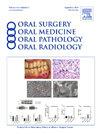A case study of an incidental finding and effects of an incomplete fracture union in the right angle of the mandible
IF 2
3区 医学
Q2 DENTISTRY, ORAL SURGERY & MEDICINE
Oral Surgery Oral Medicine Oral Pathology Oral Radiology
Pub Date : 2025-02-04
DOI:10.1016/j.oooo.2024.11.029
引用次数: 0
Abstract
Clinical Presentation
A cone beam computed tomography dataset of an 8-year-old female patient was referred to the University of Iowa College of Dentistry Radiology service for identification of the location of multiple unerupted teeth, specifically the permanent canines and mandibular lateral incisors. Upon viewing the dataset, an oblique hypodense line involving the entire width of the mandible measuring approximately 20 mm extending through the angle of the right side of the mandible was noted. The referring doctor was not aware of this finding, and the patient was not symptomatic at the time. The hypodense line extended from the facial cortex just distal to the developing mandibular right second molar to the lingual cortex. There were multiple hypodense areas surrounding the fracture plane and portions of the surrounding bone had rolled cortical margins suggestive of fibrous healing at the site. Furthermore, the portions of the mandible that were posterior to this region were found to be underdeveloped. This is a valuable finding, as previous research on this subject has been inconclusive and primarily focused on fractures involving the condyle. The fracture in question was not identified in a previous pantomograph that was subsequently provided upon requisition.
Differential Diagnosis
Fibrous union right angle fracture of the mandible.
Diagnosis and Management
Follow-up to assess osseous healing was recommended in few weeks. The patient is currently asymptomatic. If there continues to be lack of osseous healing in the follow-up radiograph, surgical intervention will be necessary to avoid further complications.
Conclusion
Routine evaluations of CBCTs can unexpectedly reveal significant findings, such as this unique fracture in the mandible. Moreover, this particular case exemplifies the remarkable healing capacity of fibrous tissue in fractures, where minimal intervention was involved. Such fractures may lead to observable impacts on the growth and development of the mandibular ramus, condyle, and coronoid processes.
求助全文
约1分钟内获得全文
求助全文
来源期刊

Oral Surgery Oral Medicine Oral Pathology Oral Radiology
DENTISTRY, ORAL SURGERY & MEDICINE-
CiteScore
3.80
自引率
6.90%
发文量
1217
审稿时长
2-4 weeks
期刊介绍:
Oral Surgery, Oral Medicine, Oral Pathology and Oral Radiology is required reading for anyone in the fields of oral surgery, oral medicine, oral pathology, oral radiology or advanced general practice dentistry. It is the only major dental journal that provides a practical and complete overview of the medical and surgical techniques of dental practice in four areas. Topics covered include such current issues as dental implants, treatment of HIV-infected patients, and evaluation and treatment of TMJ disorders. The official publication for nine societies, the Journal is recommended for initial purchase in the Brandon Hill study, Selected List of Books and Journals for the Small Medical Library.
 求助内容:
求助内容: 应助结果提醒方式:
应助结果提醒方式:


